The global dried fruit market is experiencing robust growth, driven by increasing consumer awareness of healthy snacking options and a rising demand for convenient, nutritious foods. As this market expands, the role of Dried Fruit Packaging Bags becomes critically important, not only for preserving the quality and extending the shelf life of these delicate products but also for enhancing brand appeal and ensuring food safety. Modern packaging solutions are at the forefront of this evolution, incorporating advanced materials, innovative designs, and sustainable practices to meet the diverse needs of producers and consumers alike.
Industry Trends and Market Dynamics in Dried Fruit Packaging
The dried fruit industry is witnessing significant shifts. According to a report by Grand View Research, the global dried fruit market size was valued at USD 10.7 billion in 2022 and is projected to grow at a compound annual growth rate (CAGR) of 7.2% from 2023 to 2030. This growth is directly fueling innovation in packaging. Key trends include:
- Sustainability: There's a strong push towards eco-friendly packaging materials, including recyclable, compostable, and biodegradable options, driven by consumer demand and regulatory pressures. Brands are increasingly adopting materials like Kraft paper, bio-plastics (PLA, PHA), and mono-material structures to reduce environmental impact.
- Convenience and Portability: Single-serving pouches, re-sealable zippers, and easy-open features are highly sought after by consumers leading busy lifestyles. Stand-up pouches, often with tear notches and zippers, dominate this segment.
- Premiumization and Branding: High-quality graphics, tactile finishes, and unique shapes are used to convey a premium image and differentiate products on crowded shelves. Digital printing technology is enabling more intricate and personalized designs.
- Enhanced Barrier Properties: As the market globalizes, the need for packaging that can withstand varying climates and shipping conditions, while maintaining freshness, is paramount. Multi-layered films with superior oxygen and moisture barrier properties are becoming standard.
- Food Safety and Traceability: Strict regulations globally (e.g., FDA, EFSA) necessitate packaging that ensures product integrity from farm to fork, preventing contamination and spoilage. Smart packaging features like QR codes for traceability are gaining traction.
These trends directly influence the design and manufacturing of Dried Fruit Packaging Bags, pushing manufacturers like Junlanpack to continuously innovate and provide solutions that are not only functional but also aligned with market demands and consumer values.

Understanding Dried Fruit Packaging Bags: Materials and Manufacturing Excellence
Dried Fruit Packaging Bags are specialized container111s designed to protect dried fruits from external elements, preserve their freshness, and extend their shelf life. The effectiveness of these bags hinges on the careful selection of materials and precision in their manufacturing process.
Key Properties and Material Science
The primary function of packaging for dried fruits is to create a protective barrier against factors that degrade quality, such as:
- Oxygen: Causes oxidation, leading to rancidity in fats (common in nuts and some fruits), and color/flavor degradation. High oxygen barrier (O2TR - Oxygen Transmission Rate, measured in cm³/m²/day) is crucial.
- Moisture/Water Vapor: Causes rehydration, leading to spoilage (mold growth) or hardening/crystallization of sugars. Low water vapor transmission rate (WVTR, measured in g/m²/day) is essential.
- Light (UV): Can degrade vitamins, pigments, and flavor compounds. Opaque or metallized layers provide protection.
- Contaminants: Dust, microbes, and foreign particles.
- Physical Damage: Crushing or abrasion during transport and handling.
To achieve these barrier properties and structural integrity, Dried Fruit Packaging Bags typically utilize multi-layered laminated films. Common materials include:
- PET (Polyethylene Terephthalate): Provides good stiffness, clarity, and printability. Often used as the outer layer.
- BOPP (Biaxially Oriented Polypropylene): Offers excellent clarity, good moisture barrier, and strength. Can be matte or glossy.
- PA (Polyamide, Nylon): Excellent puncture resistance, good oxygen barrier, and high temperature resistance.
- AL (Aluminum Foil): Provides an almost absolute barrier against oxygen, moisture, light, and aroma. Crucial for products highly sensitive to these elements.
- VMPET (Vacuum Metallized PET): PET film with a thin layer of aluminum vapor deposited on it. Offers good barrier properties, a metallic look, and is a cost-effective alternative to full aluminum foil.
- PE (Polyethylene): The most common sealant layer. Provides good heat sealability and moisture barrier. Available in various densities (LDPE, LLDPE, HDPE).
- CPP (Cast Polypropylene): Used as a sealant layer, offers good clarity, heat seal strength, and puncture resistance.
- Kraft Paper: For a natural, eco-friendly aesthetic. Often laminated with barrier films internally.
- Bio-plastics (PLA, PHA, PBAT): Emerging options for compostable or biodegradable solutions, laminated with other bio-based barrier films.
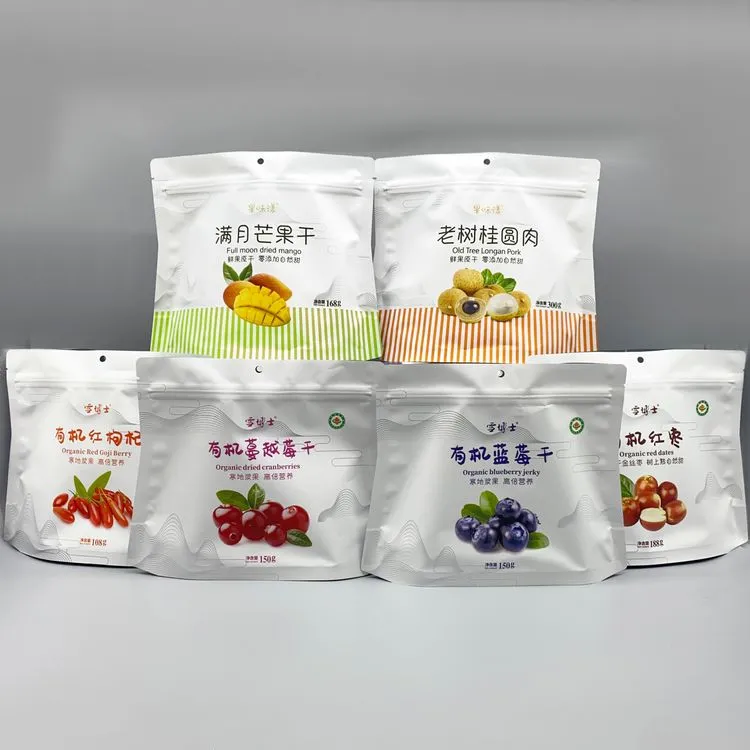
Detailed Manufacturing Process
The production of high-quality Dried Fruit Packaging Bags involves several sophisticated steps, ensuring both functionality and aesthetic appeal. While specific machinery and proprietary techniques vary, the general process flow includes:
1. Material Selection and Preparation:
- Based on product requirements (shelf life, barrier needs, aesthetic, budget), appropriate films (e.g., PET, AL, PE) are selected.
- Raw materials undergo quality checks for thickness, strength, and print readiness.
2. Printing:
- Gravure Printing: Utilizes engraved cylinders. Known for high print quality, sharp images, and vibrant colors, especially for large print runs. Ideal for intricate designs and precise color matching.
- Flexographic Printing: Uses flexible relief plates. Cost-effective for shorter runs and offers good print quality, suitable for a wide range of substrates.
- Digital Printing: Best for short runs, variable data printing, and quick turnaround. Allows for highly customized designs without the need for plates or cylinders.
- After printing, inks are cured (UV or thermal) to ensure durability and prevent smudging.
Dried Fruit Packaging Bag Manufacturing Process (Simplified Flow)
(The manufacturing process involves sophisticated machinery and trained personnel to ensure precision at each step.)
Raw Material Rolls (e.g., PET, BOPP, Aluminum Foil)
Printing (Gravure / Flexo / Digital)
Lamination (Multiple layers bonded with adhesive)
Curing (Adhesive fully bonds and strengthens film)
Slitting (Master roll cut into desired widths)
Bag Forming (Pouch machine seals and cuts into final bags)
Quality Control & Packaging (Inspection, testing, packing)
3. Lamination:
- This crucial step bonds multiple layers of film together using a high-performance adhesive. Lamination can be solvent-based, solventless, or even extrusion lamination.
- Each layer contributes specific properties (e.g., strength, barrier, printability, sealability). For instance, an outer PET layer for print, a middle AL/VMPET for barrier, and an inner PE layer for heat sealing.
- After lamination, the combined film usually undergoes a curing process in a heated tunnel to ensure complete adhesive bonding and strength, typically for 24-72 hours.
4. Slitting:
- The wide laminated master roll is cut into narrower rolls, or "web," according to the specified width required for the final bag size. This is done on precision slitting machines.
5. Bag Forming (Pouch Making):
- The slit rolls are fed into specialized pouch-making machines. These machines are highly automated and perform functions such as:
- Unwinding: Feeding the film into the machine.
- Folding: Folding the film into the desired pouch shape (e.g., flat pouch, stand-up pouch, gusseted pouch).
- Sealing: Using heat and pressure to create strong, consistent seals (side seals, bottom seals, fin seals).
- Punching: Creating features like tear notches, euro holes, or handle holes.
- Zipper/Valve Insertion: If applicable, re-sealable zippers or degassing valves are integrated.
- Cutting: Separating individual pouches.
6. Quality Control and Inspection:
- Throughout the process, stringent quality checks are performed. This includes:
- Visual Inspection: Checking for print defects, misalignments, and material flaws.
- Seal Integrity Testing: Bubble leak tests, burst tests, and tensile strength tests to ensure seals are robust and leak-proof.
- Barrier Property Testing: Measuring O2TR and WVTR to confirm barrier effectiveness.
- Dimension and Registration Checks: Ensuring bags meet specified size and print registration.
- Adhesion Testing: Checking the bond strength between laminated layers.
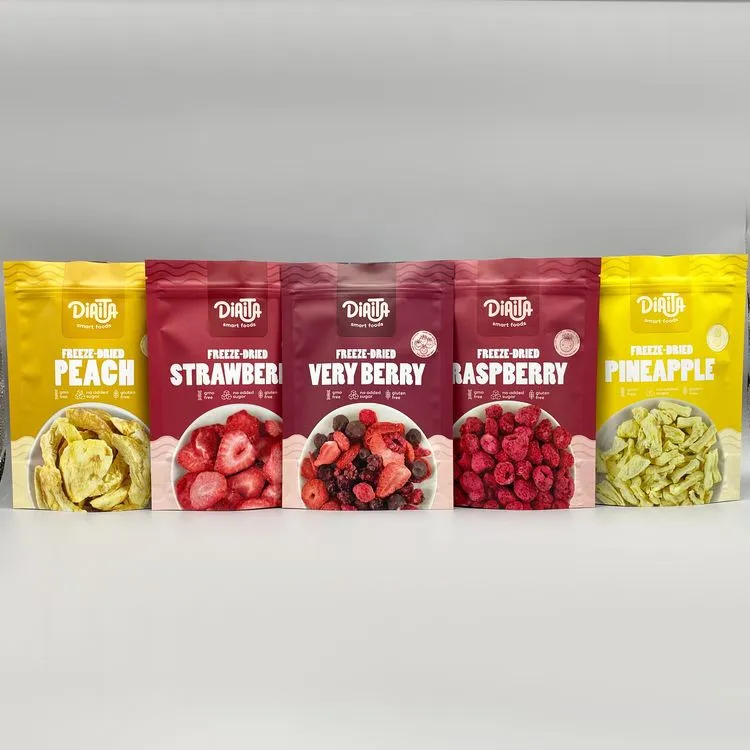
Industry Standards and Certifications
Adherence to international standards is paramount for food packaging. Reputable manufacturers comply with:
- FDA (Food and Drug Administration): For food contact materials in the USA, ensuring materials are safe for direct contact with food.
- EU Regulations (e.g., (EC) No 1935/2004): Similar to FDA, regulating food contact materials in the European Union.
- ISO 22000 (Food Safety Management Systems): Specifies requirements for a food safety management system where an organization in the food chain needs to demonstrate its ability to control food safety hazards.
- BRCGS Global Standard for Packaging Materials: Provides a robust framework for all types of packaging manufacturers to assist them in the production of safe packaging materials and to manage product quality to meet customers' requirements.
- GMP (Good Manufacturing Practices): A system for ensuring that products are consistently produced and controlled according to quality standards.
These certifications provide authoritative proof of a manufacturer's commitment to quality, safety, and operational excellence, directly enhancing trustworthiness.
Technical Parameters and Specifications of Dried Fruit Packaging Bags
Choosing the right Dried Fruit Packaging Bags requires a clear understanding of their technical specifications. These parameters directly influence performance, shelf life, and cost.
Key Parameters Table
Below is a table outlining common parameters for Dried Fruit Packaging Bags, along with their significance:
| Parameter |
Unit |
Typical Range |
Significance |
| Material Structure |
N/A |
PET/VMPET/PE, BOPP/AL/PE, Kraft/VMPET/PE, Mono-PE |
Defines barrier, strength, appearance, and recyclability. For dried fruits, multi-layer laminates are standard for superior protection. |
| Total Thickness |
Microns (µm) |
80 - 180 µm |
Influences mechanical strength (puncture resistance, tear resistance) and rigidity. Thicker bags generally offer better protection and a more premium feel. |
| Oxygen Transmission Rate (O2TR) |
cm³/(m²·day) @23°C, 0% RH |
| Critical for preventing oxidation of fats and preserving flavor. Lower values indicate better oxygen barrier. Especially important for nuts or oily dried fruits. |
| Water Vapor Transmission Rate (WVTR) |
g/(m²·day) @38°C, 90% RH |
| Essential for preventing moisture ingress or egress, which can lead to mold or hardening. Lower values indicate better moisture barrier. |
| Puncture Resistance |
Newtons (N) or Joules (J) |
Varies by test method and material, e.g., >5N for 100µm film |
Ability of the bag to resist piercing, crucial for protecting contents from sharp edges or handling impacts. Achieved with materials like PA or thicker PE. |
| Tensile Strength |
MPa (MegaPascals) |
Varies, e.g., >30 MPa (MD), >25 MPa (TD) for common films |
Measures the force required to break the film. Indicates the bag's durability during filling, sealing, and transport. |
| Seal Strength |
N/15mm or N/inch |
>10 N/15mm is generally good |
Indicates the strength of the heat seals (sides, bottom, zipper). Strong seals prevent leaks and maintain barrier integrity. Tested via burst pressure or peel strength. |
| Coefficient of Friction (COF) |
Dimensionless |
0.2 - 0.4 (low static) for good machinability |
Affects how smoothly bags run on automated packaging lines. Low COF allows for faster processing. |
| Printability |
N/A |
Excellent, Good, Fair |
Refers to the film's ability to hold ink and produce high-quality graphics. Directly impacts brand appeal. |
| Recyclability/Compostability |
N/A |
Yes/No, specific standard (e.g., EN 13432 for compostable) |
Growing importance for environmental responsibility. Mono-material PE or PP structures are recyclable, while certified bio-plastics are compostable. |
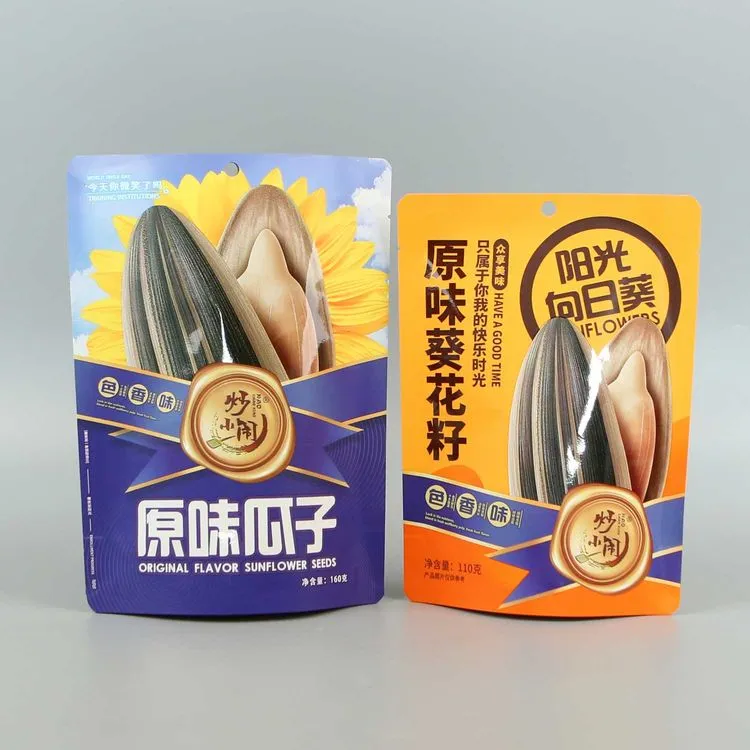
Diverse Application Scenarios and Strategic Advantages
Dried Fruit Packaging Bags are incredibly versatile, finding application across a wide spectrum of dried fruit types and market segments. Their tailored design ensures optimal performance in various scenarios, directly contributing to product success and consumer satisfaction.
Typical Application Scenarios:
- Retail Snacking: Small, convenient stand-up pouches (Doypack) or flat pouches for individual portions of raisins, cranberries, apricots, or mixed nuts. These often feature re-sealable zippers for freshness and tear notches for easy opening. The vibrant print quality helps in shelf differentiation.
- Bulk/Family Packs: Larger gusseted bags or block bottom bags for economies of scale, used for families or bulk buyers. These require robust materials and strong seals to handle heavier weights.
- Organic and Health Food Markets: Often utilize Kraft paper laminate bags or fully recyclable/compostable options to align with the product's natural and eco-conscious branding. Emphasis on clear labeling and certifications.
- Ingredient Supply (B2B): Large format bags or pouches for supplying dried fruits to bakeries, confectioneries, or other food manufacturers. Barrier properties are crucial here to maintain quality during storage before processing.
- Online Retail/E-commerce: Packaging needs to withstand the rigors of shipping. Lightweight yet durable bags, sometimes with additional protective outer packaging, are preferred. Aesthetics for unboxing experience are also important.
Advantages in Application:
- Extended Shelf Life: High-barrier films, particularly those containing aluminum foil or high-performance metallized layers, dramatically reduce oxygen and moisture ingress. This directly translates to longer shelf life, reducing food waste and allowing wider distribution channels. For example, a properly sealed pouch can extend the shelf life of sensitive dried fruits like dates or figs from a few months to over a year under optimal conditions.
- Preservation of Nutritional Value and Sensory Qualities: By minimizing exposure to light, oxygen, and moisture, the packaging helps retain the vitamins, minerals, natural flavors, and textures of the dried fruits. This is crucial for maintaining the product's premium perception.
- Enhanced Food Safety: Multi-layered structures provide a robust physical barrier against external contaminants. Heat-sealed pouches ensure tamper evidence and hygiene. Compliance with FDA and ISO standards reassures consumers and retailers.
- Superior Branding and Market Appeal: High-definition printing capabilities (gravure, flexo, digital) allow for vibrant, eye-catching graphics, detailed product information, and effective brand storytelling. Stand-up pouches offer excellent shelf presence.
- Consumer Convenience: Features like re-sealable zippers, tear notches, and clear windows (for product visibility) enhance the user experience, making the product more appealing and practical for on-the-go consumption.
- Cost-Effectiveness and Efficiency: Lightweight flexible packaging reduces shipping costs compared to rigid container111s. Its adaptability to automated filling lines increases production efficiency, lowering overall operational expenses for producers.
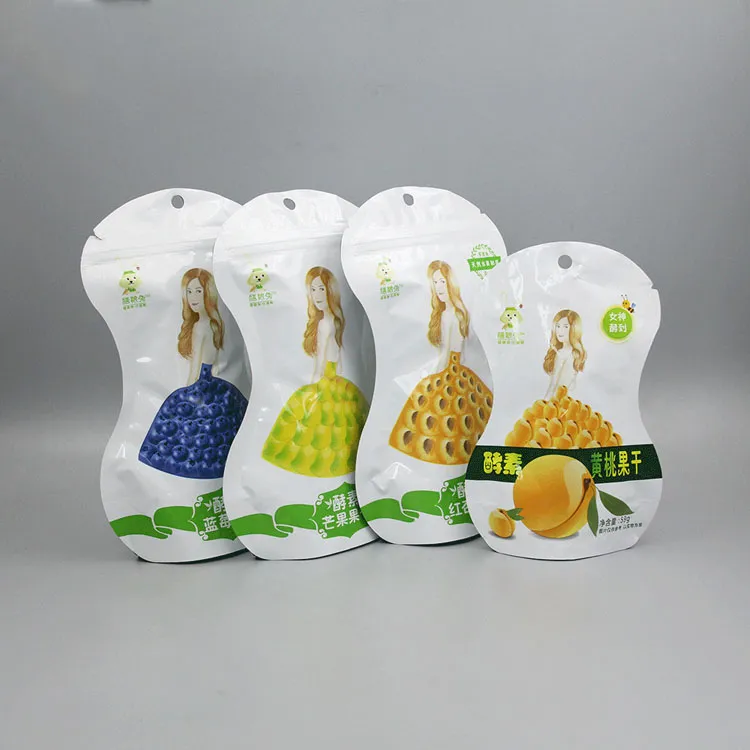
Leading Solutions: Customization and Partnering with Junlanpack
In a competitive market, generic packaging is no longer sufficient. Brands require tailored solutions that reflect their unique identity and product needs. This is where specialized manufacturers excel, offering extensive customization and a deep understanding of packaging science. Junlanpack stands as a prominent example in this domain, providing comprehensive solutions for Dried Fruit Packaging Bags.
Why Customization Matters
Custom packaging allows brands to:
- Stand Out: Unique designs, shapes, and finishes differentiate products from competitors.
- Optimize Protection: Tailored material structures based on specific product sensitivity and desired shelf life.
- Enhance Brand Image: Consistent branding elements, high-quality printing, and premium finishes reinforce brand perception.
- Improve Consumer Experience: Ergonomic designs, easy-open features, and re-sealability contribute to user satisfaction.
- Achieve Sustainability Goals: Custom solutions can incorporate specific recyclable or compostable materials to meet environmental commitments.
Junlanpack's Approach to Customization and Quality Assurance
Junlanpack has established itself as a trusted partner for Dried Fruit Packaging Bags through its commitment to quality, innovation, and client-centric solutions. Their process typically involves:
- Consultation and Needs Assessment: A detailed discussion to understand the client's specific dried fruit product (type, moisture content, oil content), target market, desired shelf life, packaging machinery, and brand aesthetics. This includes evaluating existing packaging challenges.
- Material & Structure Recommendation: Based on the assessment, expert teams recommend optimal multi-layer film structures (e.g., PET/AL/PE for maximum barrier, or Kraft/VMPET/PE for natural look with good barrier) and thickness to meet performance and budget requirements.
- Design and Prototyping: Collaborating with clients on graphic design, bag dimensions, and features (zippers, tear notches, clear windows). Digital proofs and physical prototypes are often provided for approval.
- Advanced Printing Technology: Utilizing state-of-the-art gravure and flexographic printing presses to ensure vibrant colors, sharp imagery, and precise registration that bring brand designs to life.
- Precision Manufacturing: Employing modern lamination and pouch-making machinery that adheres to stringent quality control protocols, ensuring consistent seal strength, barrier integrity, and dimensional accuracy across all bags.
- Rigorous Quality Control: Every batch undergoes comprehensive testing (e.g., O2TR, WVTR, seal strength, burst test, adhesion test) in accordance with ISO, FDA, and BRCGS standards to guarantee product integrity and safety.
- Supply Chain Management: Efficient production planning, on-time delivery, and robust logistics ensure that clients receive their packaging when and where they need it, minimizing disruptions to their operations.
Junlanpack's service commitment extends beyond delivery, offering continuous customer support and technical assistance. Their long-standing relationships with various food manufacturers serve as a testament to their reliability and expertise.
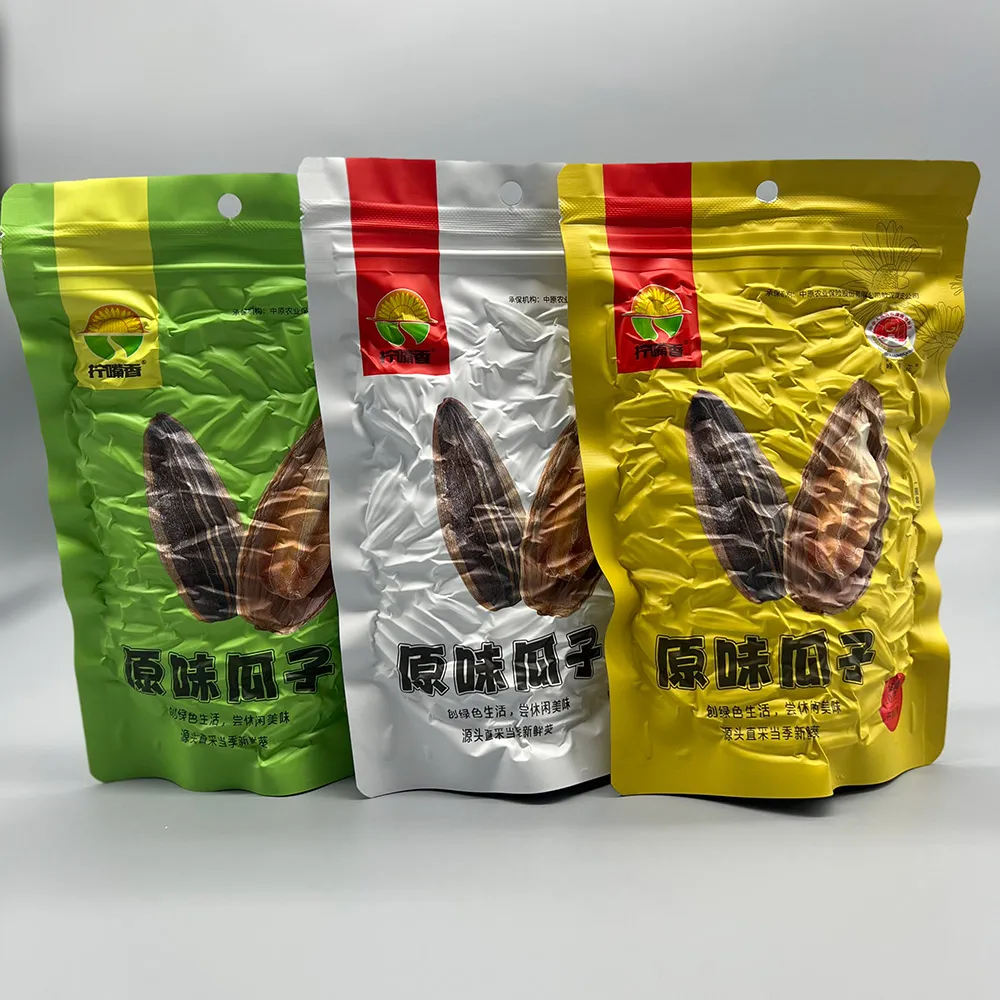
Application Cases and Customer Success Stories
The true measure of effective Dried Fruit Packaging Bags lies in their real-world performance and the tangible benefits they deliver to businesses. Below are illustrative examples of how well-designed packaging translates into market success.
Case Study 1: Extending Reach for an Organic Raisin Producer
An organic raisin producer faced challenges with short shelf life and product clumping due to moisture absorption in their previous generic packaging, limiting their distribution range. Junlanpack collaborated with them to develop a custom stand-up pouch using a high-barrier PET/VMPET/PE laminate. This structure significantly reduced O2TR and WVTR, extending the raisins' shelf life by 8 months. The new packaging's re-sealable zipper and matte finish also appealed to their health-conscious target market, leading to a 30% increase in retail presence and a 20% growth in online sales within the first year.
Case Study 2: Brand Revitalization for a Trail Mix Company
A established trail mix company with an aging brand image needed a packaging refresh. Their flat pouches were not standing out on shelves. Junlanpack designed vibrant, custom-printed block bottom bags that allowed the product to stand upright, maximizing shelf visibility. The use of soft-touch varnish on the BOPP/AL/PE film created a premium feel. This aesthetic upgrade, combined with improved barrier properties for nuts within the mix, revitalized their brand perception, resulting in positive customer feedback and a 15% increase in market share in key grocery chains.
Case Study 3: Sustainable Packaging for a Dried Mango Snack Brand
A new dried mango snack brand was committed to sustainability from inception. They sought fully compostable Dried Fruit Packaging Bags. Junlanpack provided a solution using a PLA-based multi-layer film that met industrial compostability standards (EN 13432). Despite the technical challenges of maintaining barrier with compostable materials, specialized coatings and meticulous lamination ensured sufficient shelf life. This commitment to eco-friendly packaging resonated strongly with their target demographic, earning them early market adoption and significant media attention for their sustainable practices.
The Impact on Trustworthiness and Authority
These case studies underscore the critical role of specialized packaging solutions in product success. By providing effective barrier protection, enhancing brand visibility, and incorporating consumer-friendly features, high-quality Dried Fruit Packaging Bags directly contribute to:
- Consumer Trust: Products that remain fresh, taste great, and are safely packaged build consumer confidence and loyalty.
- Retailer Confidence: Longer shelf life and robust packaging reduce spoilage and handling issues, making products more attractive to retailers.
- Brand Authority: A premium, well-protected product reinforces the brand's commitment to quality, positioning it as a leader in its category.
Frequently Asked Questions (FAQ) about Dried Fruit Packaging Bags
1. What are "barrier properties" in packaging, and why are they important for dried fruits?
Barrier properties refer to a packaging material's ability to resist the permeation of gases (like oxygen), moisture (water vapor), and sometimes light or aroma compounds. For dried fruits, these are crucial because:
- Oxygen Barrier (O2TR): Prevents oxidation of natural fats in fruits/nuts, which can lead to rancidity, off-flavors, and degradation of vitamins (e.g., Vitamin C).
- Moisture Barrier (WVTR): Controls the moisture content inside the bag. Too much moisture can lead to mold growth and spoilage, while too little can cause fruits to harden and lose palatability.
High barrier packaging extends shelf life and maintains product freshness and sensory qualities.
2. What are the most common material layers used in multi-layer Dried Fruit Packaging Bags?
Common multi-layer structures typically combine 2 to 4 layers, each serving a specific function:
- Outer Layer (e.g., PET, BOPP): Provides printability, stiffness, and acts as a protective layer against abrasion.
- Barrier Layer (e.g., AL foil, VMPET, PA/Nylon, EVOH): Offers superior barrier against oxygen, moisture, and light. Aluminum foil provides the highest barrier.
- Inner Sealant Layer (e.g., PE, CPP): Ensures the bag can be heat-sealed effectively and provides flexibility and puncture resistance.
A common high-barrier structure might be PET/AL/PE, while a more cost-effective option could be BOPP/VMPET/PE.
3. What is the difference between Gravure and Flexographic printing for packaging?
These are two primary methods for printing flexible packaging:
- Gravure Printing: Uses etched or engraved metal cylinders. It excels in delivering high-resolution images, precise color reproduction, and consistent print quality over long runs. It has higher initial setup costs (for cylinders) but lower per-unit costs for large volumes.
- Flexographic Printing: Uses flexible photopolymer plates with raised images. It's more versatile for different substrates, has lower setup costs, and is faster for shorter to medium runs. While quality has significantly improved, it's generally slightly less precise than gravure for very fine details.
The choice depends on print volume, desired quality, and budget.
4. How do Dried Fruit Packaging Bags contribute to extending product shelf life?
They extend shelf life primarily by creating an optimal micro-environment inside the bag that isolates the product from degrading factors:
- Oxygen and Moisture Control: High-barrier films minimize the ingress of oxygen (which causes oxidation and rancidity) and moisture (which leads to mold and texture changes).
- Light Protection: Opaque layers (like aluminum foil or metallized films) block harmful UV and visible light, which can degrade nutrients and colors.
- Aroma Retention: Good barrier properties also prevent the escape of volatile aroma compounds, keeping the product fresh and flavorful.
- Physical Protection: Durable materials protect against physical damage during transport and handling, preventing bag breaches that would compromise freshness.
This comprehensive protection significantly slows down the natural degradation processes of dried fruits.
5. Are there truly effective biodegradable or compostable options for Dried Fruit Packaging Bags?
Yes, significant advancements have been made in sustainable packaging. While achieving the same barrier properties as conventional multi-layer plastic/foil laminates is challenging, effective biodegradable and compostable options exist. These typically use bio-plastics like PLA (Polylactic Acid), PHA (Polyhydroxyalkanoates), or PBAT (Polybutylene Adipate Terephthalate), often combined with bio-based barrier coatings or layers. They are designed to break down in industrial composting facilities (certified by standards like EN 13432 for Europe or ASTM D6400 for North America). For dried fruits, these solutions are becoming increasingly viable, especially for brands prioritizing environmental impact, though they might require a careful balance between shelf life and sustainability goals.
6. What quality control standards should a reputable manufacturer of Dried Fruit Packaging Bags adhere to?
A reputable manufacturer should adhere to rigorous international and industry-specific quality control standards to ensure product safety and performance. Key standards and certifications include:
- ISO 9001: Quality Management Systems (general quality control).
- ISO 22000: Food Safety Management Systems (specific to food chain safety).
- FDA Compliance: Materials approved for food contact in the United States.
- EU Food Contact Regulations: Compliance with European Union standards for food contact materials.
- BRCGS Global Standard for Packaging Materials: A globally recognized standard for packaging manufacturers, ensuring product safety, legality, and quality.
- GMP (Good Manufacturing Practices): Guidelines for manufacturing to ensure quality and safety.
Adherence to these standards indicates expertise, experience, authority, and trustworthiness.
7. How do I choose the right type of Dried Fruit Packaging Bags for my product?
Choosing the right bag involves considering several factors:
- Product Nature: (e.g., moisture content, oil content, sensitivity to light/oxygen). This dictates the required barrier properties.
- Desired Shelf Life: Longer shelf life requires higher barrier films (e.g., aluminum foil laminates).
- Target Market/Brand Image: Premium products might opt for matte finishes, unique shapes (e.g., block bottom), or sustainable materials (e.g., Kraft paper).
- Filling and Sealing Equipment: Ensure the bag type is compatible with your existing or planned packaging machinery (e.g., roll stock vs. pre-formed pouches).
- Budget: Material choices and printing technologies affect cost.
- Convenience Features: Do you need zippers, tear notches, hang holes?
- Sustainability Goals: Are recyclable, compostable, or renewable material options a priority?
It's best to consult with an experienced packaging supplier like Junlanpack, who can guide you through these choices based on your specific needs.
Delivery, Warranty, and Customer Support
A crucial aspect of trustworthiness for any packaging supplier is their commitment to reliable delivery, robust quality assurance through warranty, and responsive customer support. Junlanpack understands that timely delivery and consistent quality are paramount to their clients' operational success.
Delivery Schedule and Logistics
The typical delivery timeframe for custom Dried Fruit Packaging Bags can vary based on complexity, order volume, and current production load. Generally, after final design approval and deposit, the lead time for production and delivery ranges from 15 to 30 working days. This timeframe allows for meticulous material sourcing, precision printing, lamination, curing, bag forming, and comprehensive quality checks. For repeat orders or standard specifications, lead times may be shorter. Junlanpack leverages an optimized supply chain and works with trusted logistics partners to ensure on-time delivery, minimizing downtime for their clients' production lines. Clients are provided with clear delivery schedules and real-time tracking updates where available.
Quality Assurance and Warranty Commitment
Junlanpack stands behind the quality of its Dried Fruit Packaging Bags with a comprehensive quality assurance program. Every batch undergoes rigorous testing to meet agreed-upon specifications and industry standards (FDA, ISO, BRCGS). In the unlikely event of manufacturing defects or performance issues attributable to materials or workmanship, Junlanpack offers a clear warranty. This commitment includes investigation of issues, replacement of defective products, or appropriate remedies, ensuring client satisfaction and minimizing disruption. This robust warranty policy underscores their confidence in their manufacturing process and product reliability.
Dedicated Customer Support
Effective customer support is vital for building long-term partnerships. Junlanpack provides dedicated account managers who serve as single points of contact for clients, from initial inquiry through order fulfillment and after-sales support. Their support includes:
- Technical Assistance: Guidance on packaging machinery compatibility, sealing parameters, and storage conditions.
- Design and Material Consultation: Expert advice on optimizing bag structure and graphics for specific product needs.
- Order Management: Transparent communication regarding production status, shipping updates, and reordering processes.
- Problem Resolution: Prompt and efficient handling of any concerns or issues that may arise, with a focus on quick and satisfactory resolutions.
This proactive and responsive support system enhances the overall experience and reinforces Junlanpack's reputation as a trustworthy and reliable packaging partner.
Conclusion: The Future of Dried Fruit Packaging
The landscape of the dried fruit industry is continuously evolving, driven by consumer preferences for healthy, convenient, and sustainable products. At the heart of this evolution are Dried Fruit Packaging Bags, which are no longer mere container111s but sophisticated engineering solutions critical for product preservation, brand differentiation, and market success. The advanced material science, precise manufacturing processes, and adherence to stringent quality standards highlighted in this article underscore the expertise and authority required in this field. As the industry moves forward, the emphasis on high-barrier properties, consumer convenience features, and eco-friendly solutions will only intensify, pushing manufacturers to innovate further.
For brands looking to thrive in this dynamic market, partnering with a knowledgeable and trustworthy packaging expert like Junlanpack is indispensable. Their ability to deliver customized, high-performance packaging, backed by rigorous quality control and dedicated customer support, ensures that dried fruit products reach consumers in optimal condition, enhancing brand reputation and driving sustained growth. The commitment to principles – Expertise, Experience, Authoritativeness, and Trustworthiness – is not just a guideline for content creation, but a foundational business philosophy that defines leading packaging suppliers.
References and Further Reading:
- Grand View Research. (2023). Dried Fruit Market Size, Share & Trends Analysis Report By Product, By Application, By Region, And Segment Forecasts, 2023 - 2030. Available at: https://www.grandviewresearch.com/industry-analysis/dried-fruit-market
- Robertson, G. L. (2016). Food Packaging: Principles and Practice (3rd ed.). CRC Press. (A widely cited academic textbook on food packaging science.)
- Smithers. (2023). The Future of Flexible Packaging to 2028. (Industry report on packaging trends, relevant insights often cited in packaging forums and journals). Available from industry reports aggregators or direct publishers.
- Food Safety Magazine. (Ongoing). Various articles and white papers on food packaging safety and regulations. Available at: https://www.foodsafetymagazine.com/section/packaging/